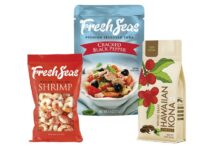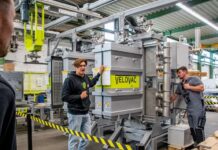It’s critical to get the packaging right in a competitive environment like the food sector. This isn’t simply for convenience’s sake; it’s also to maintain a competitive edge on crowded grocery aisles or consumer’s doorsteps. Which packaging is appropriate for your food items? There are numerous sorts to choose from, including glass, paper, corrugated, and plastic. Food packaging, on the other hand, is not all the same.
When it comes to choosing the correct food packaging, there are two important considerations to keep in mind:
- Your food product’s packaging should keep it safe
- It should draw the customer’s attention
As a wise business, you want your food packaging to be environmentally friendly and waste-free, but the harsh reality is that no single packaging material can meet all of these criteria.
What do customers desire?
GlobalWebIndex polled consumers in the United States and the United Kingdom to find out what they value most in environmentally friendly packaging. Here’s what they had to say:
- 64 percent want recyclable packaging;
- 53 percent want reusable packaging;
- 46 percent want items that don’t overpackage;
- 39 percent want compostable/biodegradable packaging;
- 36 percent want packaging derived from renewable sources and
- 35% prefer packaging that allows them to easily separate different products for disposal.
In addition, over half of customers informed GlobalWebIndex that they had cut back on the number of plastic disposable they used in the preceding 12 months.
According to PMMI, The Association for Packaging and Processing Technologies’ 2019 Trends and Advances in Food Packaging and Processing, whilst also consumers presently prefer materials made from recycled goods that can also be recycled.
Plastics- A history leading to its shortcomings
Since the 1950s, over 8.3 billion tons of plastic have been manufactured globally, and we already generate 300 million tons of plastic waste per year, as per the United Nations Environment Programme (UNEP). According to the organization, just 9% of all plastic garbage generated has been recycled, with the remaining 79% going to landfill, dumps, or the environment. Corked bottles, caps, food wrappers, grocery bags, straws, and stirrers are the second most prevalent sort of plastic trash behind cigarette butts, forcing the food and beverage industry to take action. Not only is the industry attempting to address the issue of single-use plastic, but it is also looking for long-term alternatives to materials like polyethylene terephthalate (PET) in water bottles and biscuit trays, high-density polyethylene (HDPE) in milk jugs and ice cream containers, and low-density polyethylene (LDPE) in food trays, containers, and packaging film.
Plastic packaging and things we don’t know
Of course, this is not a new tendency. Packaging with plastic has been used since the 1950s, and in the 1980s and 1990s, it effectively took over. A plastic bottle can take up to 450 years to degrade, yet we throw away a lot of them. As per a 2019 survey, recyclable packaging is significant to 64 percent of consumers in the US & UK. Reusable packaging was noted by just over half of them, and biodegradable packaging was mentioned by 39 percent. 93 percent of packaged products companies already say they’re devoting more time to environmental issues than in previous years.
Food wastage bloats up packaging spoilage too
In the EU, around 100 tons of food is wasted each year, accounting for nearly 30% of the agri-food supply chain (1), resulting in significant environmental consequences (high carbon footprint and blue water footprint, vain land use, etc.) (2) and (3). By 2050, food waste is expected to reach over 200 million tons, necessitating a 50 percent increase in world food supplies (4, 5). Even if the link among shelf-life and food waste isn’t clear, a substantial portion of food loss is due to the short shelf-life of many fresh fruits and vegetables due to their biological nature. Furthermore, it is estimated that food date label mistakes or misunderstandings account for approximately 20% of the needless waste of still-edible food (6).
When a food product is wasted, the packaging is discarded as well, adding to the environmental burden. Packaging materials are primarily oil-based in our plastic-based economy. Between 2015 and 2016, global plastic production climbed by 4.2 percent to 335 million tons. Each year, Europe produces 23 million tons of plastic packaging (92 million tons expected in 2050) (7). After a sole, extremely brief usage as food packaging, 40% of it ends up in landfill, resulting in 9 million tons of plastic packaging waste that would eventually accumulate in soils. 32 percent escape through collection and sorting systems, eventually ending up in the soil and ocean (8,9). This marine and soil litter degrades into micro- and ultimately nano-sized particles, which can easily penetrate living species like fish and be fed up the food chain to humans, with dramatic long-term negative consequences (10). If current production and use patterns continue, and nothing is done, by 2050 there will be more plastic in the ocean than fish in terms of weight (11).
The need for bio-packaging products is expanding worldwide. For example, the European market for bio-based polymers (biodegradable or not) is currently worth over € 4.5 billion, with a CAGR (Compound Annual Growth Rate) of 21%, and has reached around 2 million tons in 2020. (12). However, with just 2% of the global polymer industry, this sector is still quite modest. Biodegradable polymer-based packaging accounts for just 0.8 million tons and € 2 billion in bio-based polymers in 2016. (13). Technical hurdles relating to the operational and manufacturing specificities of bio-based materials, which differ significantly from petrochemical plastics, are the principal impediment to commercial adoption.
Indeed, the carbon emissions of food produced but not consumed (about 100 million tons per year in the EU) is projected to be 495 million tons of CO2. The blue water footprint (i.e., the use of surface and groundwater resources) of EU food waste is around 37 km3, or half the size of Lake Geneva. Food that has been produced but not consumed takes up over 210 million hectares of land. Food waste might reach over 200 million tons by 2050 when nothing is done, according to modelling (14,15).
Meanwhile, the European Union produces 23 million tons of plastic packaging each year (92 million tons expected in 2050). If current production and use patterns continue, the plastic industry will produce 1,124 million tons of plastic materials worldwide by 2050, accounting for 20% of total oil consumption and 15% of the carbon budget (16), and if nothing is done, there may be more plastic in the ocean than fish by weight (17).
By promoting market uptake of packaging innovations that enable the extension and better management of food shelf-life, food waste at the retail and consumer tier could be reduced by half by 2050, saving about 100 million tons of food, equivalent to 250 million tons of CO2, 18 km3 of water resources, and 100 million hectares of land (18). This accomplishment is in line with EU goals. (19)
By 2050, if one out of every two food packs is made of a “bio-benign” material, 50 percent of packaging waste could be avoided, resulting in a reduction of 46 million tons of plastic waste, reducing the negative effects of plastic buildup in natural systems and the long-term adverse effects expected.
By 2050, a net saving of roughly 43 MTOE of virgin oil-based resources is projected at the European level, and more than 150 MTOE at the global level, if one pack out of two is replaced with organic waste-based packaging. These savings equate to an absolute reduction of 120 million tons of CO2-eq (20) in the EU and 500 million tons of CO2-eq globally (direct CO2 emissions only).
In summary, at the European level, expected reductions in both food and packaging waste, thanks to viable food packaging solutions, would result in a net reduction of 370 million tons of CO2-eq, or a net saving of about 10% of GHG emissions, based on the 2050 EU goal of staying within the 2°C limit (IEA 450 scenario, EEA greenhouse gas–data viewer).
Our current plastic-based packaged food economy is a classic linear application: 98 percent of the 78 million tons of plastic packaging produced annually in Europe comes from virgin oil-based feedstock, and only 14 percent of it is recycled after use, far below global recycling rates for paper (58 percent) (21) and iron and steel (70–90 percent) (22). Plastic packaging is still disposed of in 40% of cases, and more than 30% escapes into biological ecosystems (especially oceans). By 2050, the utilization of oil resources by the whole plastics industry will account for 20% of overall oil consumption if current significant growth in plastics usage continues (23). Currently, 8 million tons of plastics seep into the ocean every year, totaling 150 million tons of plastic garbage in the ocean (24), with packaging accounting for 62 percent of it.
References:
- Gustavsson J, Cederberg C, Sonesson U, van Ottedijk R, Meybeck A. Global food losses and food waste: extent, causes and prevention. In: Interpack2011 SAVE FOOD! Düsseldorf: FAO.
- HLPE. Food Losses and Waste in the Context of Sustainable Food Systems. Rome (2014).
- Vermeulen SJ, Campbell BM, Ingram JSI. Climate change and food systems. Annu Rev Environ Resour. (2012) 37:195–222. doi: 10.1146/annurev-environ-020411-130608
- United Nations Food and Agriculture Organisation (2009). How to Feed the World in 2050. Rome (2009). doi: 10.1111/j.1728-4457.2009.00312.x
- Scialabba N. Food Wastage Footprint: Impacts on Natural Resources – Summary Report. FAO; Food and Agricultural Organization of the United Nations (2013).
- Stenmarck Å, Jensen C, Quested T, Moates G. FUSIONS: Estimates of European Food Waste Levels. Stockholm (2016).
- PlasticsEurope, Plastics—the Facts 2013 (2013); PlasticsEurope, Plastics—the Facts 2015 (2015).
- World Economic Forum, Ellen MacArthur Foundation and McKinsey Company. The New Plastics Economy: Rethinking the Future of Plastics (2016). doi: 10.1103/Physrevb.74.035409
- Jambeck JR, Geyer R, Wilcox C, Siegler TR, Perryman M, Andrady A, et al. Plastic waste inputs from land into the ocean. Science (2015) 347:768–71. doi: 10.1126/science.1260352
- European Commission’s Directorate-General Environment. Plastic waste: ecological and human health impacts. Sci Environ Policy (2011) 41:159–72. doi: 10.1016/B978-012311632-1/50042-5
- World Economic Forum, Ellen MacArthur Foundation and McKinsey Company. The New Plastics Economy: Rethinking the Future of Plastics (2016). doi: 10.1103/Physrevb.74.035409
- Smithers Pira. The Future of Bioplastics for Packaging to 2020: Global Market Forecasts. Smithers Pira (2013).
- Schlechter M. Biodegradable Polymers (PLS025D). ABCC research report (2011).
- FAO. Climate Change and Global Food Systems: Global Assessments and Implications for Food Security and Trade (2015). Available online at: http://www.fao.org/3/a-i4332e.pdf
- Hall KD, Guo J, Dore M, Chow CC. The progressive increase of food waste in America and its environmental impact. PLoS ONE (2009) 4:e7940. doi: 10.1371/journal.pone.0007940
- Energy used in production and carbon released through incineration and/or energy recovery after-use (i.e., 20% in 2050). Carbon budget based on 2 degree scenario.
- World Economic Forum, Ellen MacArthur Foundation and McKinsey Company. The New Plastics Economy: Rethinking the Future of Plastics (2016). doi: 10.1103/Physrevb.74.035409
- FAO. Food Wastage Footprint – Impacts on Natural Resources (2013). Available online at http://www.fao.org/docrep/018/i3347e/
- http://www.un.org/sustainabledevelopment/sustainable-consumption-production/
- 1 toe 11630 kWh and 0.24 kg CO2/kWh.
- International Council of Forest and Paper Associations, Statement on Paper Recycling (2014).
- Graedel TE, Dubreuil A, Gerst M, Hashimoto S, Moriguchi Y, Müller D, et al. UNEP Recycling rates of metals – A Status Report, A Report of the Working Group on the Global Metal Flows to the International Resource Panel (2011).
- World Economic Forum, Ellen MacArthur Foundation and McKinsey Company. The New Plastics Economy: Rethinking the Future of Plastics (2016). doi: 10.1103/Physrevb.74.035409
- Jambeck JR, Geyer R, Wilcox C, Siegler TR, Perryman M, Andrady A, et al. Plastic waste inputs from land into the ocean. Science (2015) 347:768–71. doi: 10.1126/science.1260352



























